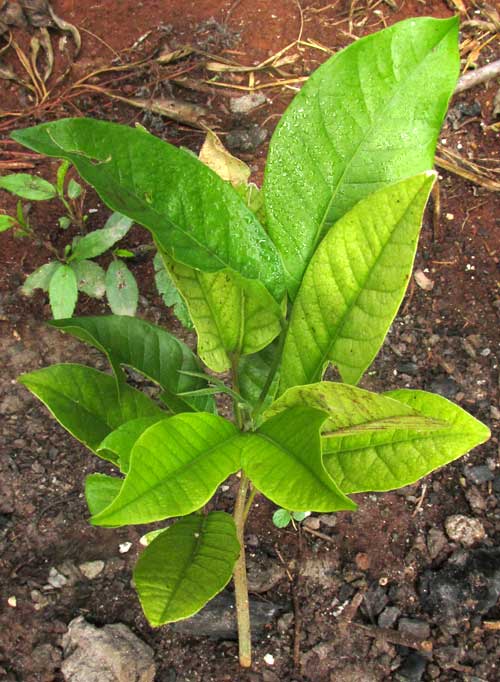Excerpts from Jim Conrad's
Naturalist Newsletter
from the August 6, 2017 Newsletter issued from Rancho Regenesis in the woods ±4kms west of Ek Balam Ruins; elevation ~40m (~130 ft), N20.876°, W88.170°; north-central Yucatán, MÉXICO
MOBILE & IMMOBILE NUTRIENTS
At www.backyardnature.net/mexnat/ackee.htm you are introduced to the Ackee tree, famous for producing a highly edible food much used in Jamaica, and found planted along a street in Mérida awhile back. My friend Eric provided me with seeds, the seeds germinated, I planted them months ago, and then after an initial spurt of fast development, the plants almost stopped growing and began looking malnourished. Now all my seedlings have died except one, and it doesn't look so healthy. You can see it below:

Two things to notice: First, the lower leaflets display "interveinal chlorosus." Chlorosus is when vegetation fades from its normal deep green color, turning pale and somewhat yellowish. The term "interveinal" just means "between the veins," so the interveinal chlorosus in our plant is shown by the network of dark green veins in otherwise yellowish leaflets.
The second thing to notice is that the lower, older leaflets are displaying interveinal chlorosus, but the upper, newer ones are more evenly darker green.
These two facts were very important when I began to diagnose my Ackee seedling's problems. My diagnoses was based on the fact that some plant nutrients are mobile while others are immobile. Helping me along was a web document I freely downloaded in PDF format, from the University of New Hampshire, at http://e-gro.org/14_images/webinars/11_19_13_nutrition.pdf.
Another web page helping out, sponsored by Michigan State University page, was at http://msue.anr.msu.edu/news/knowing_nutrient_mobility_is_helpful_in_diagnosing_plant_nutrient_deficienc.
First of all, 17 elements are recognized as vital to plant growth. Of these, 14 must be dissolved in soil water in order to be taken up by root. Of these 14, three are used in relatively large quantities, and are considered "primary plant nutrients." They are: Nitrogen, Phosphorous, and Potassium.
Three more elements are considered "secondary nutrients": Calcium, Magnesium and Sulfur.
The eight remaining elements are "micronutrients," needed in small quantities, but nonetheless they are essential. They are Boron, Chlorine, Copper, Iron, Manganese, Molybdenum, Nickel and Zinc.
Notice that in our context we're using the terms "elements" and "nutrients" interchangeably.
Some of these 17 elements can be moved around inside the plant, and are considered mobile; others have to stay where they are originally placed. If a growing plant is suffering a nutrient deficiency, it wants to scavenge its limited supply of that element from old leaves and sent to its more efficiently photosynthesizing new growth, but it can move only its mobile nutrients.
Our Ackee seedling has shifted mobile nutrients from its older, lower leaves, causing interveinal chlorosus there, to produce its darker, greener, newer upper leaves. Since our little Ackee has moved its nutrients from below to above, and this caused the lower leaves' interveinal chlorosus, the Ackee is having problems with one or more mobile nutrients.
The mobile nutrients are Nitrogen, Phosphorus, Potassium, Magnesium, Chlorine and Molybdenum.
Nitrogen deficiency normally causes a uniform chlorosus, not chlorosus just between the veins. Phosphorus deficiency normally results in deep green foliage, not chlorosus. Potassium deficiency produces a brief chlorosus at the tip and margins of old leaves. Magnesium deficiency causes interveinal chlorosus on older leaves...
So, we may have Magnesium deficiency. A couple of other nutrients, Sulfur and Molybdenum, are partially mobile. However, Sulfur causes a general chlorosus and death (necrosis) of young leaves, and Molybdenum causes a narrow chlorotic band around the leaf margin, developing into necrosis, so it's neither of those.
We're led to Magnesium but there's another consideration. Nutrient availability can be affected by such things as a low pH (acid soil), low temperatures, water-clogged soil, and soil compaction.
Of these, in our case soil compaction is a real possibility, since our limestone-based, clayey soil compacts very easily.
I read that the best way to treat garden plants showing Magnesium deficiency is to spray the leaves with a solution containing Epsom salts. Applying compost to soil reduces the possibilities of Magnesium deficiency.